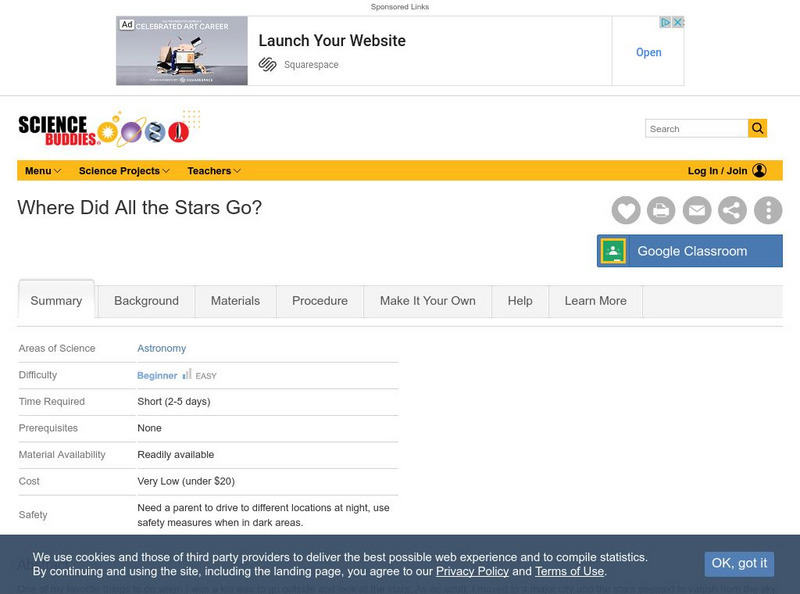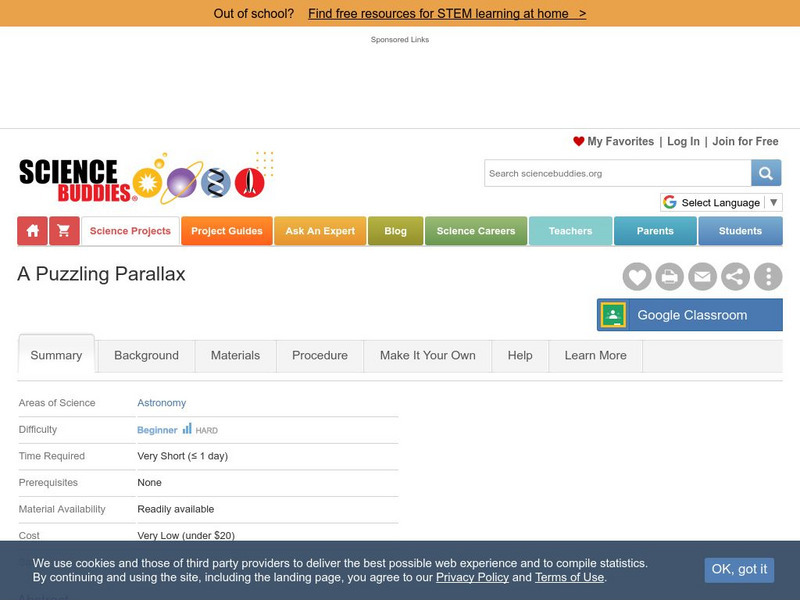Hi, what do you want to do?
Curated OER
Pinhole Viewer
Learners make a pinhole viewer to demonstrate how it inverts light passing through it which produces inverted images.
Curated OER
Color Recognition
Students envision how space observatories make use of monochromatic filters to collect data on the color of objects in space. They see the actual colors of objects when they are in monochromatic light.
Curated OER
Probes to Other Planets
Sixth graders use a list of robot components and common household items to design and construct a robot spacecraft model suitable for exploring the Saturn System. They present the robots to the class.
Curated OER
Reading Comprehension 6
Set the timer for five minutes (or less), and distribute this resource to your class. There's a very short reading passage followed by a set of three questions. What a great tool in prepping your class for upcoming state testing.
Curated OER
Get the Picture!
Astronomers practice downloading data from a high-energy satellite and translate the data into colored or shaded pixels. As a hands-on activity, they use pennies to simulate high-energy satellite data and they convert their penny...
Curated OER
How Did the First Asteroid Come to be Discovered?
Pupils examine asteroids including how and when they were discovered. In this asteroid lesson students view a PowerPoint presentation on asteroids.
Curated OER
Lotto or Life: What Are the Chances?
Though the website does not seem to have the mentioned video, a reding and lottery style games simulate the chances of finding intelligent life somewhere other than Earth. Without the video, this lesson is short, but it can be a useful...
Curated OER
The Drake Equation
Students use the Drake Equation to calculate the probability of sustaining life on various planets. Through the use of the equation, they determine whether intelligent and advanced civilizations can be developed on planets other than...
Curated OER
Earth is Round?
Third graders discuss how Aristotle concluded that the Earth was round. As a class, they review theories about the Earth's shape and describe how life on Earth would be different if it were flat. Individually, they make a moon book in...
Curated OER
Coordinates
In this coordinates worksheet, 6th graders solve ten multiple choice questions by using their knowledge of coordinates on a grid. This is an interactive worksheet.
Curated OER
Sun and Moon Poetry Baskets
Students write Sun and Moon poetry. In this poetry lesson, students research the sun and the moon. They write poetry and create two class baskets for descriptive words about each.
Curated OER
Scientific Method
In this scientific method activity, students read and discuss a 2 page article on the scientific method, match 3 founders of the scientific method with what they found or produced, answer 4 statements as true or false, list 3 crucial...
Curated OER
News to the Core Reported by Very Special Students
Students create news articles that help them build their knowledge, skills, and academic confidence. In this special education lesson, students use previous knowledge to write a newsletter and demonstrate their understanding of various...
Curated OER
Mark Zuckerberg
In this famous people worksheet, students read a selection about the life of Mark Zuckerberg, then complete a variety of comprehension activities including synonym matches, fill-in-the-blank sentence completions, unscrambling words and...
Curated OER
Taking Risks: Drug and Alcohol Abuse
Students discuss a video about drug and alcohol abuse and their connection to risk-taking. They answer questions on a risk factor sheet about the use of tobacco, drugs, and alcohol. They discuss long and short term goals and how not...
Curated OER
Celestial Reflections: See Yourself in the Sky!
Students create a mirror/mirror frame using glass mosaic tiles, grout, and various other mosaic supplies.
Science Buddies
Science Buddies: Which Stars Can You Use for Navigation
A great science project from Science Buddies that examines how ancient peoples navigated without the benefit of a GPS. Find out which stars are important in navigation in the northern and southern hemispheres. The Science Buddies project...
Library of Congress
World Digital Library: Astronomy: Reaching for the Stars
In this article the contributions of the Islamic world to our knowledge of astronomy is discussed.
Ducksters
Ducksters: Space Science: Astronomy for Kids
Kids learn about astronomy, the study of outer space including the stars, planets, comets, black holes, and the Solar System. History and astronomers in this astronomy for teachers and kids section.
Science Buddies
Science Buddies: Where Did All the Stars Go?
If you live in a big city or urban area it is hard to see many stars at night. In most urban areas only the most brilliant stars, planets and the moon can be seen. This is because of something called light pollution which is the...
Science Buddies
Science Buddies: The Moon and the Stars
When you are in the city, only a few of the brightest stars are visible. But when you are in the country, you can see many more stars than you can count. Sometimes you can even see the bright belt of our galaxy, the Milky Way. In this...
Science Buddies
Science Buddies: A Puzzling Parallax
Did you know that ancient astronomers could measure the distance to other stars? They could also distinguish between stars and planets. How could they do that without modern technology of telescopes? See if you can discover the link...
Science Buddies
Science Buddies: Changing Constellations
Do you like to look up into the night sky? There are so many stars, it can be mind boggling. Some ancient people marked time by the changes in star patterns. We still use changes in constellation patterns to mark astronomical time. This...




























